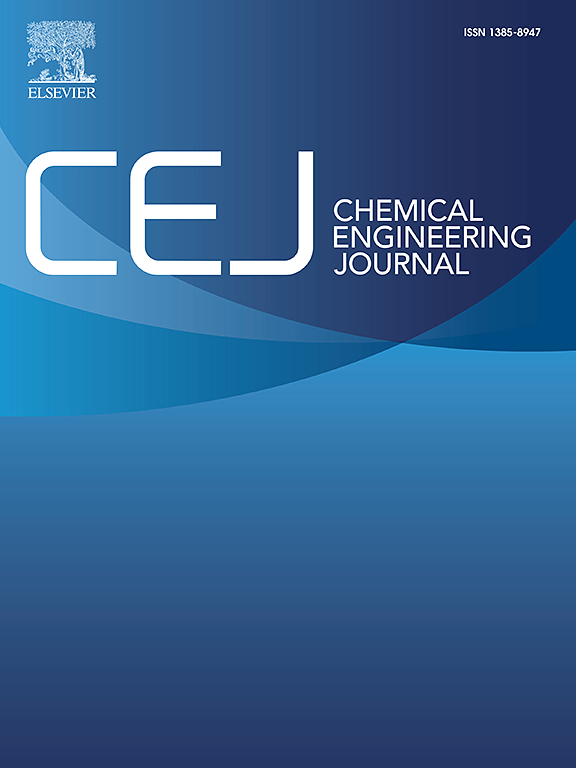Granulation of a planktonic thermophilic anammox culture enables high rate nitrogen removal from warm nitrogen rich wastewater: A proof of concept
IF 13.2
1区 工程技术
Q1 ENGINEERING, CHEMICAL
引用次数: 0
Abstract
Anaerobic ammonium oxidation (anammox) process has been widely studied for nitrogen removal from organic carbon-deficient wastewaters at mesophilic conditions (<40 °C). While two recent studies have reported the enrichment of thermophilic anammox communities, their high-rate nitrogen removal potential in scalable reactors remains unexplored, which is critical to treat warm nitrogen-rich wastewaters (45-60 °C). This study illustrates the first successful cultivation of granular thermophilic anammox sludge utilizing a planktonic enrichment culture as inoculum, demonstrating the highest thermophilic nitrogen removal rates in an expanded granular sludge bed reactor at 50 °C. A stepwise increase in hydraulic upflow velocity (HUV) from 2 to 10 m/h and nitrogen loading rate (NLR) from 0.24 to 1.11 kgN/m3/d promoted the transition from planktonic growth to coarse aggregates, while a sudden reduction in HUV to 0.2 m/h triggered their transformation into stable granules, showing high specific anammox activity (0.8–1 gNH4+-N/gVSS/d) and morphological characteristics similar to their mesophilic counterparts. Granulation enabled high biomass accumulation, achieving a steady state nitrogen removal rate of 8.57 ± 0.05 kg N/m3/d, the highest reported for thermophilic anammox. Microbial community analysis revealed that Candidatus Brocadia remained the dominant anammox genus, with a high relative abundance of 64–80% during granulation. Structural extracellular polymeric substances (EPS) from thermophilic anammox granules showed higher extraction yields than mesophilic counterparts, containing β-sheet-rich proteins as the predominant fraction. These findings provide technical insights into anammox granulation utilizing planktonic cells and establish a foundation for developing thermophilic anammox-based processes for treating warm nitrogen-rich wastewaters such as, reject water from thermophilic anaerobic digestion of sewage sludge.

浮游嗜热厌氧氨氧化培养物的造粒使高速率的氮从温暖的富氮废水中去除:概念的证明
厌氧氨氧化(anammox)工艺已被广泛研究在中温条件下(<40 °C)从有机碳缺乏的废水中去除氮。虽然最近有两项研究报道了嗜热厌氧氨氧化菌群落的富集,但它们在可扩展反应器中的高速率脱氮潜力仍未得到探索,这对于处理温暖富氮废水(45-60 °C)至关重要。该研究首次成功地利用浮游富集培养物作为接种物培养出颗粒型嗜热厌氧氨氧化污泥,并在50 °C的膨胀颗粒污泥床反应器中显示出最高的嗜热氮去除率。水力上升流速度(HUV)从2 ~ 10 m/h逐步增加,氮负荷速率(NLR)从0.24 ~ 1.11 kgN/m3/d逐步增加,促进了浮游生长向粗团聚体的转变,而HUV突然降低至0.2 m/h,促使其转变为稳定的颗粒,表现出较高的厌氧氨氧化活性(0.8 ~ 1 gNH4+-N/gVSS/d),形态特征与中亲水性相似。造粒可实现高生物量积累,稳态氮去除率为8.57 ± 0.05 kg N/m3/d,是报道的最高的嗜热厌氧氨氧化菌。微生物群落分析显示,厌氧氨氧化菌属以Candidatus Brocadia为主,在造粒过程中相对丰度高达64 ~ 80%。从嗜热厌氧氨氧化颗粒中提取的结构胞外聚合物(EPS)的提取率高于中温厌氧氨氧化颗粒,其主要成分是富含β-片的蛋白质。这些发现为利用浮游细胞进行厌氧氨氧化造粒提供了技术见解,并为开发基于厌氧氨氧化的厌氧氨氧化工艺处理富氮废水(如污水污泥厌氧消化产生的废水)奠定了基础。
本文章由计算机程序翻译,如有差异,请以英文原文为准。
求助全文
约1分钟内获得全文
求助全文
来源期刊

Chemical Engineering Journal
工程技术-工程:化工
CiteScore
21.70
自引率
9.30%
发文量
6781
审稿时长
2.4 months
期刊介绍:
The Chemical Engineering Journal is an international research journal that invites contributions of original and novel fundamental research. It aims to provide an international platform for presenting original fundamental research, interpretative reviews, and discussions on new developments in chemical engineering. The journal welcomes papers that describe novel theory and its practical application, as well as those that demonstrate the transfer of techniques from other disciplines. It also welcomes reports on carefully conducted experimental work that is soundly interpreted. The main focus of the journal is on original and rigorous research results that have broad significance. The Catalysis section within the Chemical Engineering Journal focuses specifically on Experimental and Theoretical studies in the fields of heterogeneous catalysis, molecular catalysis, and biocatalysis. These studies have industrial impact on various sectors such as chemicals, energy, materials, foods, healthcare, and environmental protection.
 求助内容:
求助内容: 应助结果提醒方式:
应助结果提醒方式:


